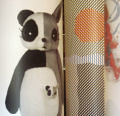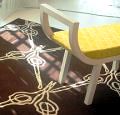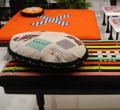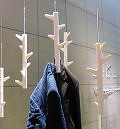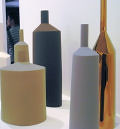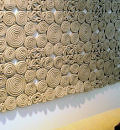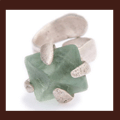ask a designer: judy ross (answers)

Q: Do you try to incorporate how your design will ultimately look in a room into your design process? And if so how does this attitude affect your designs?
A:I really start with a blank piece of square paper and put my ideas. I do sometimes try to create a design that would have a good feeling say in a very modern room but mostly I create with my own standards in mind. My design sense is all about a bold graphic with a slight imbalance/dynamics going on…
Q: What about competition? I've seen pieces at West Elm that look a lot like Judy's work and I wonder what her views on copying are. How do you protect your work or do you just try to ignore the copiers?
A: I do protect my work by copy righting all my designs in Washington D.C. In the end the best is to ignore all those copiers and just keep moving forward. I do think West Elm should be taught a lesson…they are one of the worst copiers and it is very unfair what they are doing. They should hire us as designers for them, instead of plagiarizing our work. (Anthropologie also!)
Q:How did you get your business off the ground. I'm a textile designer who recently graduated from FIT and I'm having a hard time getting a loan. How did you make the financial end happen to get things moving? And, how did you find the money to hire a staff and pay people. I need help but can't imagine making enough money to pay someone.
A: At the beginning, I worked freelance with embroidery companies in the garment center and used this money to finance my business.I also had a job in Paris where I designed embroideries for a company and this paid very well and I used those earnings also. The manufacturers who produced my pillows/rugs gave me long periods of time to pay them back, which helped a lot.. In the beginning I did not have an assistant for the first two years, as I grew the business. I am proud to say I never took out a loan and I built up credit. I was lucky to have a style that is mine and a excellent product. That is the key to my success.
Q: I am a designer and I've always been limited by making everything myself. I have started working with other people who are sewing for me, so I can spend more time designing and printing! I'm finding it nearly impossible to get the quality of work I'm looking for, and I feel exhausted from unsuccessfully searching for someone in my city (Buenos Aires) who can work with my quality standards. I am starting to wish I could just go back to making everything myself! So, I wonder if Judi has any advice or words of inspiration about finding and working with subcontractors and negotiating about quality. Also, I'm curious, how often do you add new designs to your line, and how long do you keep each design in your collection?
A: You have to persevere and keep looking until you find the right subcontractors. You cannot go back to making it yourself because you will never grow. There should be people out there who can sew a quality piece. It took me a few manufacturers to get exactly what I wanted and I still have to keep on top of them. So do not give up. I do a new collection twice a year. This is a lot to keep up but it is the part I enjoy the most so I make the effort. Most of my designs stay in the collection, for example Procession that I produced in 1995, I still produce today. Sometimes a design will disappear for a few years but I will bring it back. I think the beauty of my designs is that they are timeless and work in many situations.
Q: I wondering about getting your products out there. How did you in the beginning get the much needed exposure? Was it through press or did you take part in the many shows? If it was through the press how did you get their attention? Do you have any advice for doing it all on a VERY limited budget? Please don't tell me it was luck.
A: My advice on a limited budget is to make beautiful pictures and have them inkjet printed from your computer. Present yourself with a nice logo and packaging. Send this out to all the magazines. If it is something worthy they will answer you. It is their job to find and feature new and interesting projects. My work is very graphic and is very photogenic so it works well when sent out to the press. Also it is helpful to do a trade show because all the press walk them in search of new products. This is hard on a limited budget.
Q: How do you manage your time between raising your children and running a company? I just gave birth to my second and the idea of caring for both kids and trying to find time to create seems impossible. I'd love any tips on time management you have. That and managing the guilt of being away from them!
A: It is very difficult to do both and you have to put limitations to each in order to manage. I have two boys, 5 and 10 and between my company and my children, I am very busy. My tips are to be very organized and surround yourself with good people who can help you with all your responsibilities. I forfeit going out a lot to all these design events to be home with my children most every night. This does hurt my business in a way but you have to make choices as to what is more important. I love my work and I try to balance as best I can being a mother and a woman with a career. The guilt is there many times …but I do think there is something to say for children who see their mother working successfully in her craft. I try to do wonderful things with them and be there as much as I can after a working day of 9 to 6.
Q: I was wondering how you find good production resources? (seems like a scary and ambiguous world). I'm assuming you use several different factories depending on the product(?). do you ever need to travel to oversee the production? Kudos to you for balancing such a great career while raising a child!
A: Finding production can be a difficult task. I was lucky to meet people on one of my trips to India in 1989, and I have worked with some of them since. It did take a number of years of training as to what the quality had to be. Now that there is the internet, it is quite easy to research manufacturers and get in touch. It does take a trip to really organize and be sure that the work is being done properly. Since I have had my two boys, I have not had to travel since I have set up the production properly at the start. When the boys are older, I hope to take them on a wonderful trip to India to see how it all gets done. They are very aware and proud of my work and it will be fun for them to meet all the manufacturers who they have heard me speak to all these years (and yell at a bit from time to time).
Q: My question for Judy is if she has any advice for someone who is thinking about doing to school for textile arts. Did she know exactly what she wanted to do right from the start? What was her vision for her future when she was starting out? Thanks very much.
A: I actually went to school for painting. I took textile courses as a backup , since I knew I could make money doing designs, repeats and colorings. The boundaries of my painting and textile design training meshed into one and I began painting on fabric. My vision became clear when I took a job in India and fell in love with the embroideries which I came upon during my visits. You have to start with something you enjoy and see where life leads you.
Q: How do you choose colors? Do you watch for up coming trends, or just go with your instincts?
A: I like to do a little of both.. I have my own color sense which I always draw upon when I am designing. But having worked in the Fashion world, I do enjoy looking at their color trends. I find it helps to key into some of the trends in color, especially when you are selling to very fashionable trendy stores.

